|
|
DUSKO GOYKOVICH
Biography
|
Dusko Goykovich
Biography
DUSKO GOYKOVICH - Short biography by
Scott Yanow
Born in 1931 in Jajce (Bosnia), Dusko Goykovich [trumpet,
flugelhorn, composer] studied at the Music Academy in Belgrade from 1948 to
1953. As a youth he played with several jazz and dixie bands, mostly for dancing
audiences and eventually on parties at the embassies of the capital. When the
18-year-old joined the Radio Big Band of Belgrade, he was considered a talented
young jazz man who also can read music. When he left the band five years later,
he had grown into a fine big band player and featured soloist.
Dusko went to Germany where he quickly became an integral part
of its uprising young jazz scene. In 1956 he made his first record as a member
of the Frankfurt All-Stars. After a short stint in the big band of Munich's
Max Greger, Dusko stayed for four and a half years with Kurt Edelhagen's band,
then Europe's leading jazz orchestra. Francy Boland, Claus Ogermann, Jerry van
Rooyen and Rob Pronk were among the arrangers who worked for Edelhagen. In addition
to being the band's premier trumpet soloist, Dusko performed with such as Stan
Getz and Chet Baker. It came as no surprise when in 1958 he was invited to play
with the Newport International Youth Band at the Newport Jazz Festival. Other
members of the Newport band included Albert Mangelsdorff, Ronnie Ross, George
Gruntz, and Gábor Szábo.
Following the performance at Newport, Dusko's trumpet became
very popular in Europe. In 1961 the Berklee School of Music offered the 29-year-old
a grant for studying composition and arrangement in Boston where Herb Pomeroy
was to become one of his teachers. Looking forward to writing his own arrangements
for his great love, the big band, Dusko concentrated on his studies at Berklee
so exclusively that he regrettingly turned down offers by Count Basie, Stan
Kenton and Benny Goodman to join their bands. While at Berklee Dusko (now also
on flugelhorn) recorded with the Berklee School Quintet and Orchestra including
fellow students such as Gary Burton, Mike Gibbs, Sadao Watanabe, Steve Marcus,
Mike Nock, and Dave Young.
When he had just finished his studies and prepared his return
to Germany, Dusko received a call from Canadian bandleader Maynard Ferguson
offering him Rolf Ericson's place (who had just left to join Ellington). Of
course, Dusko accepted. Ferguson, a virtuoso trumpeter himself, featured him
as a second trumpet soloist and even used some of his big band arrangements.
When Ferguson's band split in 1964, Dusko joined Woody Herman and stayed with
him for a year. It was his work for Herman that founded Dusko's international
reputation as an outstanding big band player and soloist. "Woody Herman
encouraged me a lot," Dusko recalls. "He not only accepted my big
band charts (with a single exception), but also recorded all of them."
The same year Dusko (together with Sal Nistico) left Herman's
band and returned to Europe, eager to record his own music. Mal Waldron and
Nathan Davis played on his sextet album "Swinging Macedonia" (1966)
that emphasized Dusko's personal, Balkan-influenced style. In those years, Dusko
- by then a member of the leading league of international jazz artists - also
worked with Miles Davis, Dizzy Gillespie, Gerry Mulligan, Clark Terry, Lee Konitz,
Sonny Rollins, Phil Woods, Duke Jordan, Thad Jones-Mel Lewis, Slide Hampton
and many more.
He continued his big band career as a member of the Clarke-Boland
Big Band in 1966 that assembled some of the best musicians living in Europe,
among them US ex-patriates Benny Bailey, Idrees Sulieman, Johnny Griffin, Sahib
Shihab, Jimmy Woode and - of course - Kenny Clarke. The CBBB was probably the
finest jazz orchestra of the sixties, but it seldom played for live audiences
at all.
After his time at Berklee, Dusko Goykovich began writing big
band charts of all of his compositions and many standard tunes. He has been
asked to play his arrangements with many European big bands, among them Dutch
Skymasters and NDR big band. In Munich (where he settled down in 1968) Dusko
soon started his own "rehearsal" big band including such as Rolf Ericson,
Palle Mikkelborg, Rudi Fuesers, Ack van Rooyen, Ferdinand Povel, and Frank St.
Peter. Due to the difficulties in organizing a European free-lance orchestra,
this band broke up in 1976 and was revived only for some performances in 1981/82.
Yet in 1986 Dusko was able to re-found his own orchestra which
has been on the scene ever since. In 1993, he also started a much-acclaimed
international comeback as a recording artist with his prize-winning CD "Soul
Connection" featuring Tommy Flanagan, Jimmy Heath, Eddie Gomez and Mickey
Roker. "Soul Connection" was followed by "Bebop City" which
featured young alto sax wizard Abraham Burton, Kenny Barron on piano, Ray Drummond
on bass and Alvin Queen on drums.
1996 saw the fulfillment of a long standing wish for Dusko:
the recording of his own big band playing his music, "Balkan Connection".
1997 saw the release of the 2-CD set "Balkan Blue", another high point
in his career. Disc One features a wonderfully relaxed quintet with Italian
master saxophonist Gianni Basso and Disc Two is an extended work performed by
the NDR Philharmonic with a jazz rhythm section and Dusko Goykovich as soloist.
His compositions arranged by Palle Mikkleborg (who had done a similar piece
of work for Miles Davis). "Balkan Blue" evokes strong memories of
Miles Davis work with Gil Evans - a seminal recording of our days.
Dusko Goykovich's albums on enja:
|
|
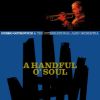
ENJ-9482 2
A HANDFUL O' SOUL |
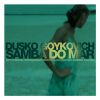
ENJ-9473 2
SAMBA DO MAR |
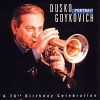
ENJ-9427 2
PORTRAIT |
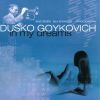
ENJ-9408 2
IN MY DREAMS |
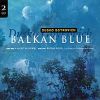
ENJ-932022
BALKAN BLUE |
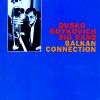
ENJ-9047 2
THE BALKAN CONNECTION |
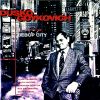
ENJ-9015 2
BEBOP CITY |
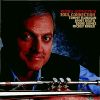
ENJ-8044 2
SOUL CONNECTION |
+++++++++++++++++++++++++++++++++++++++++++++++++++++++++++
More info available here:
www.enjarecords.com
+++++++++++++++++++++++++++++++++++++++++++++++++++++++++++
| 
